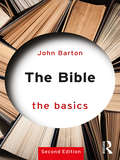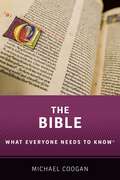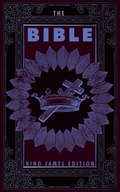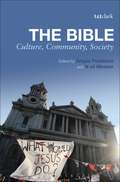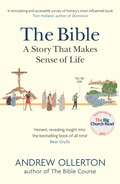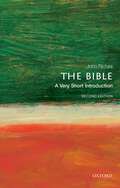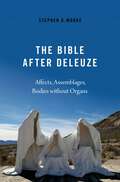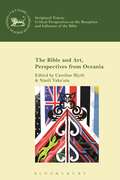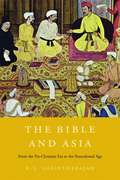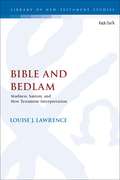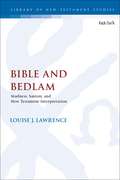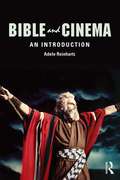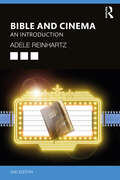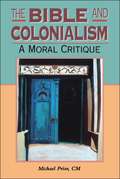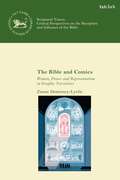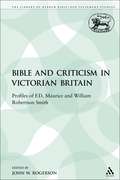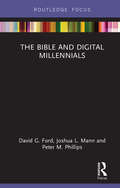- Table View
- List View
The Bible: The Basics (The\basics Ser. (PDF))
by John BartonThe Bible: The Basics is an accessible and engaging introduction to the Bible as both a sacred text, central to the faith of millions, and a classic work of Western literature, containing a tapestry of genres, voices, perspectives and images. This guide skilfully addresses both aspects of the Bible’s character by exploring: the rich variety of literary forms, from poetry to prophecy and epistles to apocalypses the historical, geographic and social context of the Bible contemporary attitudes to the Bible held by believers and non-believers the status of biblical interpretation today The second edition has been updated throughout and includes: maps and detailed suggestions for further reading. This is an ideal starting point for people of any faith or none who are studying the Bible in any setting or simply want to know more about the best-selling book of all time.
The Bible: The Basics (The Basics)
by John BartonThe Bible: The Basics is an accessible and engaging introduction to the Bible as both a sacred text, central to the faith of millions, and a classic work of Western literature, containing a tapestry of genres, voices, perspectives, and images. This guide skilfully addresses both aspects of the Bible’s character by exploring: the rich variety of literary forms, from poetry to prophecy and epistles to apocalypses; the historical, geographic, and social context of the Bible; contemporary attitudes to the Bible held by believers and non-believers; the status of biblical interpretation today. The second edition has been updated throughout and includes maps and detailed suggestions for further reading. This is an ideal starting point for people of any faith, or none, who are studying the Bible in any setting or who simply want to know more about the best-selling book of all time.
The Bible: What Everyone Needs to Know® (What Everyone Needs to Know)
by Michael CooganThe Bible is the most influential book in Western history. As the foundational text of Judaism and Christianity, the Bible has been interpreted and reinterpreted over millennia, utilized to promote a seemingly endless run of theological and political positions. Adherents and detractors alike point to different passages throughout to justify wildly disparate behaviors and beliefs. Translated and retranslated, these texts lead both to unity and intense conflict. Influential books on any topic are typically called "bibles." What is the Bible? As a text considered sacred by some, its stories and language appear throughout the fine arts and popular culture, from Shakespeare to Saturday Night Live. In Michael Coogan's eagerly awaited addition to Oxford's What Everyone Needs to Know® series, conflicts and controversies surrounding the world's bestselling book are addressed in a straightforward Q&A format. This book provides an unbiased look at biblical authority and authorship, the Bible's influence in Western culture, the disputes over meaning and interpretation, and the state of biblical scholarship today. Brimming with information for the student and the expert alike, The Bible: What Everyone Needs to Know ® is a dependable introduction to a most contentious holy book.
The Bible: A Global History
by Bruce Gordon'Wonderful' JOHN BARTON'A stupendous intellectual achievement' ANDREW PETTEGREE'A stunning love song to the Bible . . . this will be a classic' CHINE MCDONALDThe remarkable story of the most influential book in human history. The Bible is the world's best-known text. Yet, it is a book that never was - its original form does not exist and probably never did. What we have is the inheritance of generation after generation of Christians who have sought to hear God speak. Available in over three thousand languages and taking innumerable forms, each version is a revelation, evolving as a reflection of its own culture and moment. Bruce Gordon traces the Bible's astounding journey from its emergence as a codex in the second century, to the Reformation, to the spectacular growth of Christianity in the Global South today. For centuries a source of inspiration, it has also been a tool for violence and oppression, weaponised in the name of colonialism, and it has expressed hopes for freedom in the struggle for liberation. Found in desert monasteries and Chinese house churches, in Byzantine cathedrals and Guatemalan villages, it has been a book in motion from its very beginnings, a product of more than two thousand years of wandering, restlessness and change. Breathtakingly global in scope, The Bible is a sweeping history of this sacred book told through the stories of its diverse human encounters in search of the divine - revealing not a static text but a living, dynamic cultural force.
The Bible
by Random HouseOriginally produced for the Church of England, The King James Version is one of the most enduring translations of The Bible. It's combination of poeticism and readability have made it the most prominent version of the best-selling book in human history. Penguin Random House Canada is proud to bring you classic works of literature in e-book form, with the highest quality production values. Find more today and rediscover books you never knew you loved.
The Bible: Culture, Community, Society
by Angus Paddison Neil MesserWhat kind of authority does Scripture have? How is Scripture's authority to be negotiated in relation to other sources of authority? And what are the implications of confessing the Bible to be authoritative? The Bible: Culture, Community and Society seeks to answer these questions, covering three core themes. First, reading the Bible in the context of modernity - the challenges the intellectual history of modernity has posed to the Bible's authority and how historical work can co-exist with a commitment to the Bible as the Word of God. Secondly, the Bible as a text that forms the church community - how the Bible as an authoritative text shapes a culture. Thirdly, reading the Bible as a public text and the challenges posed by holding to the Bible as the Word of God in a religiously diverse context. The highly distinguished contributors include Ben Quash, David Ferguson, Angus Paddison and Zoë Bennett.
The Bible: A Story that Makes Sense of Life
by Andrew Ollerton'Honest, revealing insight into the bestselling book of all time.'Bear Grylls'A stimulating and accessible survey of history's most influential book.'Tom Holland, historian and author of Dominion'Personal and profound; informative and practical. If you want to experience the Bible as a rich source of guidance and hope, this book is for you.'Simon Thomas, former Sky Sports and Blue Peter presenterWhen we make sense of the Bible, the Bible makes sense of us.The political, social and cultural upheaval of our times can leave us feeling bewildered and wondering where to turn for trustworthy guidance. As unlikely as it may seem, could the Bible provide ancient wisdom that helps us flourish today? Join Andrew Ollerton as he explores the storyline of Scripture, connecting six major biblical events with six definitive human needs: for meaning, freedom, peace, community, love and for an ultimate home. In short, digestible chapters, Andrew reveals how the Bible story makes sense of our human story.Discover for yourself a limitless source of guidance and hope in the face of so much uncertainty.Underpinned by a depth of scholarship, the book is non-technical in style, making it accessible for the widest possible readership - including Christians and seekers interested in the Bible. The book will also provide a model for Bible communicators and church leaders wishing to engage more deeply with the relevance of the Bible in our cultural moment. Contains discussion questions for small groups, as well as suggested Bible readings and reflection questions to accompany each chapter.
The Bible: A Very Short Introduction (Very Short Introductions)
by John RichesVery Short Introductions: Brilliant, Sharp, Inspiring The Bible is one of the world's most read and most influential books. It has provided many rules for people to live by, and has shaped our language and our shared beliefs in ways that have both drawn communities together and fueled bitter disputes and conflicts. Having played a major role in the development of Western culture, the Bible continues to exert an enormous influence over millions of lives. This Very Short Introduction explores the material, cultural, and religious history of the Bible. Looking first at how the books of the Bible came to be written down and collected as authoritative sacred texts, John Riches goes on to show how they were produced and distributed across the world, and how they have been read and interpreted by differing communities in different languages. Riches compares how Jewish and Christian communities have interpreted the same passage of the Bible, and looks at some of the strikingly varied readings a very short book like Galatians has received over 2,000 years. Finally, he explores post-colonial and feminist readings of the Bible, and concludes by surveying the uses of the Bible in art, music, poetry, and politics. ABOUT THE SERIES: The Very Short Introductions series from Oxford University Press contains hundreds of titles in almost every subject area. These pocket-sized books are the perfect way to get ahead in a new subject quickly. Our expert authors combine facts, analysis, perspective, new ideas, and enthusiasm to make interesting and challenging topics highly readable.
The Bible: A Very Short Introduction (Very Short Introductions)
by John RichesVery Short Introductions: Brilliant, Sharp, Inspiring The Bible is one of the world's most read and most influential books. It has provided many rules for people to live by, and has shaped our language and our shared beliefs in ways that have both drawn communities together and fueled bitter disputes and conflicts. Having played a major role in the development of Western culture, the Bible continues to exert an enormous influence over millions of lives. This Very Short Introduction explores the material, cultural, and religious history of the Bible. Looking first at how the books of the Bible came to be written down and collected as authoritative sacred texts, John Riches goes on to show how they were produced and distributed across the world, and how they have been read and interpreted by differing communities in different languages. Riches compares how Jewish and Christian communities have interpreted the same passage of the Bible, and looks at some of the strikingly varied readings a very short book like Galatians has received over 2,000 years. Finally, he explores post-colonial and feminist readings of the Bible, and concludes by surveying the uses of the Bible in art, music, poetry, and politics. ABOUT THE SERIES: The Very Short Introductions series from Oxford University Press contains hundreds of titles in almost every subject area. These pocket-sized books are the perfect way to get ahead in a new subject quickly. Our expert authors combine facts, analysis, perspective, new ideas, and enthusiasm to make interesting and challenging topics highly readable.
The Bible After Deleuze: Affects, Assemblages, Bodies Without Organs
by Stephen D. MooreThe impact of Gilles Deleuze on critical thought in the opening decades of the twenty-first century rivals that of Jacques Derrida or Michel Foucault on critical thought in the closing decades of the twentieth. The "Deleuze and..." industry is in overdrive in the humanities, the social sciences, and beyond, busily connecting Deleuzian philosophy to everything from literature to architecture, metaphysics to mathematics, ethics to physics, sexuality to technology, and ecology to theology. What of Deleuze and the Bible? What does the Bible become when it is plugged into the Deleuzian corpus? An immense affective assemblage, among other things. And what does biblical criticism become in the process? A practice of close reading that is other than interpretation and renounces the concept of representation. Not just for those already familiar with the work of Deleuze, the book begins with an extended introduction to Deleuzian thought. It then proceeds to unexegetical explorations of five successive themes: Text (how to make yourself a Bible without Organs, and why); Body (why there are no bodies in the Bible, and how to read them anyway); Sex (a thousand tiny sexes, a trillion tiny Jesuses); Race (Jesus and the white faciality machine); and Politics (democracy, despots, pandemics, ancient prophets). Cumulatively, these explorations limn the fluid contours of a Bible after Deleuze.
The Bible After Deleuze: Affects, Assemblages, Bodies Without Organs
by Stephen D. MooreThe impact of Gilles Deleuze on critical thought in the opening decades of the twenty-first century rivals that of Jacques Derrida or Michel Foucault on critical thought in the closing decades of the twentieth. The "Deleuze and..." industry is in overdrive in the humanities, the social sciences, and beyond, busily connecting Deleuzian philosophy to everything from literature to architecture, metaphysics to mathematics, ethics to physics, sexuality to technology, and ecology to theology. What of Deleuze and the Bible? What does the Bible become when it is plugged into the Deleuzian corpus? An immense affective assemblage, among other things. And what does biblical criticism become in the process? A practice of close reading that is other than interpretation and renounces the concept of representation. Not just for those already familiar with the work of Deleuze, the book begins with an extended introduction to Deleuzian thought. It then proceeds to unexegetical explorations of five successive themes: Text (how to make yourself a Bible without Organs, and why); Body (why there are no bodies in the Bible, and how to read them anyway); Sex (a thousand tiny sexes, a trillion tiny Jesuses); Race (Jesus and the white faciality machine); and Politics (democracy, despots, pandemics, ancient prophets). Cumulatively, these explorations limn the fluid contours of a Bible after Deleuze.
The Bible and Art, Perspectives from Oceania (The Library of Hebrew Bible/Old Testament Studies)
by Caroline Blyth Nasili Vaka’utaThis volume takes readers on a fascinating journey through the visual arts of Aotearoa New Zealand, Australia and the Pacific Islands, contemplating the multivocal dialogues that occur between these artistic media and the texts and traditions of the Bible. With their distinctively antipodean perspectives, contributors explore the innovative ways that both creators and beholders of Oceanic arts draw upon their contexts and cultures in order to open up creative engagements with the stories, themes and theologies of the biblical traditions. Various motifs weave their way throughout the volume, including antipodean landscapes and ecology, (post)colonialism, philosophy, Oceanic spiritualities and the often contested engagements between western and indigenous cultures. Within this weaving process, each essay invites readers to contemplate these various forms of visual culture through Oceanic eyes, and to appreciate the fresh insights that this process can bring to reading and interpreting the biblical traditions. The result is a rich and interdisciplinary array of conversations that will capture the attention of readers within the fields of biblical reception studies, cultural studies, theology and art history.
The Bible and Asia: From The Pre-christian Era To The Postcolonial Age
by R. S. SugirtharajahThe Bible's influence on the West has received much more attention than its complex career in the East. R. S. Sugirtharajah's expansive study of Asia's idiosyncratic relationship with the Bible tells of missionaries, imperialists, and reformers who molded Biblical texts in order to influence religion, politics, and daily life from India to China.
The Bible and Asia: From The Pre-christian Era To The Postcolonial Age
by R. S. SugirtharajahThe Bible's influence on the West has received much more attention than its complex career in the East. R. S. Sugirtharajah's expansive study of Asia's idiosyncratic relationship with the Bible tells of missionaries, imperialists, and reformers who molded Biblical texts in order to influence religion, politics, and daily life from India to China.
Bible and Bedlam: Madness, Sanism, and New Testament Interpretation (The Library of New Testament Studies)
by Louise J. LawrenceBible and Bedlam first critically questions the exclusion and stereotyping of certain biblical characters and scholars perceived as 'mad', as such judgements illustrate the 'sanism' (prejudice against individuals who are diagnosed or perceived as mentally ill) perpetuated within the discipline of Western biblical studies. Second, it seeks to highlight the widespread ideological 'gatekeeping' - 'protection' and 'policing' of madness in both western history and scholarship - with regard to celebrated biblical figures, including Jesus and Paul. Third, it initiates creative exchanges between biblical texts, interpretations and contemporary voices from 'mad' studies and sources (autobiographies, memoirs etc.), which are designed to critically disturb, disrupt and displace commonly projected (and often pejorative) assumptions surrounding 'madness'. Voices of those subject to diagnostic labelling such as autism, schizophrenia and/or psychosis are among those juxtaposed here with selected biblical interpretations and texts.
Bible and Bedlam: Madness, Sanism, and New Testament Interpretation (The Library of New Testament Studies #594)
by Louise J. LawrenceBible and Bedlam first critically questions the exclusion and stereotyping of certain biblical characters and scholars perceived as 'mad', as such judgements illustrate the 'sanism' (prejudice against individuals who are diagnosed or perceived as mentally ill) perpetuated within the discipline of Western biblical studies. Second, it seeks to highlight the widespread ideological 'gatekeeping' - 'protection' and 'policing' of madness in both western history and scholarship - with regard to celebrated biblical figures, including Jesus and Paul. Third, it initiates creative exchanges between biblical texts, interpretations and contemporary voices from 'mad' studies and sources (autobiographies, memoirs etc.), which are designed to critically disturb, disrupt and displace commonly projected (and often pejorative) assumptions surrounding 'madness'. Voices of those subject to diagnostic labelling such as autism, schizophrenia and/or psychosis are among those juxtaposed here with selected biblical interpretations and texts.
Bible and Cinema: An Introduction
by Adele ReinhartzThis is a comprehensive introduction to the ways in which the Bible has been used and represented in mainstream cinema. Adele Reinhartz considers the pervasive use of the Bible in feature films, and the medium of film as part of the Bible’s reception history. The book examines how films draw on the Old and New Testament and the figure of Jesus Christ in various direct and indirect ways to develop their plots, characters, and themes. As well as movies that set out explicitly to retell biblical stories in their ancient context, it explores the ways in which contemporary, fictional feature films make use of biblical narrative. Topics covered include: how filmmakers make use of scripture to address and reflect their own time and place. the Bible as a vehicle through which films can address social and political issues, reflect human experiences and emotions, explore existential issues such as evil and death, and express themes such as destruction and redemption. the role of the Bible as a source of ethics and morality, and how this connection is both perpetuated and undermined in a range of contemporary Hollywood films. films that create an experience of transcendence, and the ways in which the Bible figures in that experience. Reinhartz offers insightful analysis of numerous films including The Ten Commandments and The Shawshank Redemption, paying attention to visual and aural elements as well as plot, character, and dialogue. Students will find this an invaluable guide to a growing field.
Bible and Cinema: An Introduction
by Adele ReinhartzThis is a comprehensive introduction to the ways in which the Bible has been used and represented in mainstream cinema. Adele Reinhartz considers the pervasive use of the Bible in feature films, and the medium of film as part of the Bible’s reception history. The book examines how films draw on the Old and New Testament and the figure of Jesus Christ in various direct and indirect ways to develop their plots, characters, and themes. As well as movies that set out explicitly to retell biblical stories in their ancient context, it explores the ways in which contemporary, fictional feature films make use of biblical narrative. Topics covered include: how filmmakers make use of scripture to address and reflect their own time and place. the Bible as a vehicle through which films can address social and political issues, reflect human experiences and emotions, explore existential issues such as evil and death, and express themes such as destruction and redemption. the role of the Bible as a source of ethics and morality, and how this connection is both perpetuated and undermined in a range of contemporary Hollywood films. films that create an experience of transcendence, and the ways in which the Bible figures in that experience. Reinhartz offers insightful analysis of numerous films including The Ten Commandments and The Shawshank Redemption, paying attention to visual and aural elements as well as plot, character, and dialogue. Students will find this an invaluable guide to a growing field.
Bible and Cinema: An Introduction
by Adele ReinhartzBible and Cinema: An Introduction is a comprehensive examination of how the Bible has been used and represented in mainstream cinema to develop its plots, characters, and themes. The book considers two general types of films: Bible movies that retell biblical stories, such as the Exodus and the life of Jesus, and Bible-related movies that make use of biblical books, stories, verses, and figures, and Bibles themselves to tell non-biblical, often fictional, narratives. Topics covered include: the contribution of Bible and Bible-related movies to the history of the Bible’s reception; the ways in which filmmakers make use of scripture to address and reflect their own time and place; the Bible as a vehicle through which films can address social and political issues, reflect human experiences and emotions, explore existential issues such as evil and death, and express themes such as destruction and redemption; the role of the Bible as a source of ethics and morality, and how this role is both perpetuated and undermined in a range of contemporary Hollywood films; and film as a medium for experiences of transcendence, and the role of the Bible in creating such experiences. This thoroughly updated second edition includes insightful analysis of films such as Noah, Gods and Men, Mary Magdalene, and The Shawshank Redemption, paying attention to visual and aural elements as well as plot, character, and dialogue. The book also includes pedagogical resources including discussions of film theory, as well as key words and discussion questions. Teachers, students, and anyone interested in the intersection of Bible and cinema will find this an invaluable guide to a growing field.
Bible and Cinema: An Introduction
by Adele ReinhartzBible and Cinema: An Introduction is a comprehensive examination of how the Bible has been used and represented in mainstream cinema to develop its plots, characters, and themes. The book considers two general types of films: Bible movies that retell biblical stories, such as the Exodus and the life of Jesus, and Bible-related movies that make use of biblical books, stories, verses, and figures, and Bibles themselves to tell non-biblical, often fictional, narratives. Topics covered include: the contribution of Bible and Bible-related movies to the history of the Bible’s reception; the ways in which filmmakers make use of scripture to address and reflect their own time and place; the Bible as a vehicle through which films can address social and political issues, reflect human experiences and emotions, explore existential issues such as evil and death, and express themes such as destruction and redemption; the role of the Bible as a source of ethics and morality, and how this role is both perpetuated and undermined in a range of contemporary Hollywood films; and film as a medium for experiences of transcendence, and the role of the Bible in creating such experiences. This thoroughly updated second edition includes insightful analysis of films such as Noah, Gods and Men, Mary Magdalene, and The Shawshank Redemption, paying attention to visual and aural elements as well as plot, character, and dialogue. The book also includes pedagogical resources including discussions of film theory, as well as key words and discussion questions. Teachers, students, and anyone interested in the intersection of Bible and cinema will find this an invaluable guide to a growing field.
The Bible and Colonialism: A Moral Critique (Biblical Seminar)
by Michael PriorThe biblical claim of the divine promise of land is integrally linked with a divine mandate to exterminate the indigenous people. The narrative has supported virtually all Western colonizing enterprises (e.g. in Latin America, South Africa, Palestine), resulting in the suffering of millions of people, and loss of respect for the Bible. According to modern secular standards of human and political rights, what the biblical narrative calls for are war-crimes and crimes against humanity. In this provocative and compelling study, Prior protests at the neglect of the moral question in conventional biblical studies, and attempts to rescue the Bible from being a blunt instrument in the oppression of people.
The Bible and Comics: Women, Power and Representation in Graphic Narratives (The Library of Hebrew Bible/Old Testament Studies)
by Dr. Zanne Domoney-LyttleThis interdisciplinary volume seeks to trace the diverse ways in which stories of biblical women have been reimagined in and as comic books. Feminist biblical scholarship has previously addressed the tradition that relegates female biblical characters to secondary roles, merely enabling the male characters to attain their own goals. Using examples from both secular and religious comic Bibles, and comic Bibles aimed at children and older audiences, Zanne Domoney-Lyttle now fully considers contemporary remediations of biblical narratives to the same degree. Remediating ancient, biblical text into modern, graphical comic books affects the reception of the text in several ways. This book aims to investigate how the production, format, and function of comic Bibles encourages the depiction of biblical characters from a contemporary perspective, while also showing some fidelity to the text. By presenting a focused analysis on women in the Bible, wider issues concerning popular-cultural retellings of the Bible in general begin to surface, including matters concerning reception history, the space between art and literature inhabited by biblical comics, and issues of translation and interpretations within contemporary remediations.
The Bible and Comics: Women, Power and Representation in Graphic Narratives (The Library of Hebrew Bible/Old Testament Studies)
by Dr. Zanne Domoney-LyttleThis interdisciplinary volume seeks to trace the diverse ways in which stories of biblical women have been reimagined in and as comic books. Feminist biblical scholarship has previously addressed the tradition that relegates female biblical characters to secondary roles, merely enabling the male characters to attain their own goals. Using examples from both secular and religious comic Bibles, and comic Bibles aimed at children and older audiences, Zanne Domoney-Lyttle now fully considers contemporary remediations of biblical narratives to the same degree. Remediating ancient, biblical text into modern, graphical comic books affects the reception of the text in several ways. This book aims to investigate how the production, format, and function of comic Bibles encourages the depiction of biblical characters from a contemporary perspective, while also showing some fidelity to the text. By presenting a focused analysis on women in the Bible, wider issues concerning popular-cultural retellings of the Bible in general begin to surface, including matters concerning reception history, the space between art and literature inhabited by biblical comics, and issues of translation and interpretations within contemporary remediations.
The Bible and Criticism in Victorian Britain: Profiles of F.D. Maurice and William Robertson Smith (The Library of Hebrew Bible/Old Testament Studies)
by John W. RogersonThis book contains the F.D. Maurice lectures for 1992 and six Gifford lectures of 1994. The Maurice lectures present the first account of Maurice as an Old Testament interpreter. The lectures on Smith concentrate upon his theological interests as an interpreter of the Bible, as well as the first account based on unpublished material of Smith's activity as a preacher. There is also a close investigation of Smith's links with Germany, and the influence upon him of Richard Rothe is investigated in some detail for the first time. One of the aims of the book is to show how, in their different ways, Maurice and Smith tried to relate the Old Testament to the two different periods of Victorian Britain in which they lived. The book also is intended as a further contribution to our knowledge of the history of biblical criticism in Britain.
The Bible and Digital Millennials (Routledge Focus on Religion)
by David G. Ford Joshua L. Mann Peter M. PhillipsThe Bible and Digital Millennials explores the place of the Bible in the lives of 18 to 35 year-olds who have been born into the digital age. As the use of digital media becomes increasingly pervasive, it should follow that it will have a significant effect on people’s engagement with religion and the sacred texts associated with it. Drawing on contemporary in-depth surveys, this study unpacks digital millennials’ stance towards, use of and engagement with the Bible in both offline and online settings. The book features results from a nationally representative survey of 2,000 young British people specifically commissioned for this project. The data is also compared with the findings of others, including a poll of 850 British Bible-centric Christians and recent Bible engagement surveys from the USA. This book investigates the relevance of the Bible to the lives of those who have grown up in the digital age. It will, therefore, offer fresh insight to any scholar of biblical studies, religion and digital media, and religious studies.
